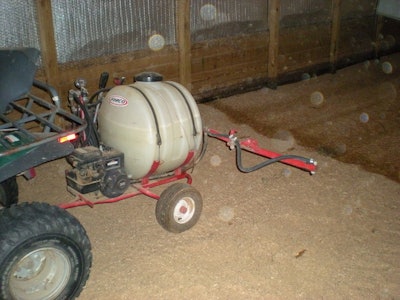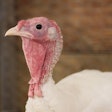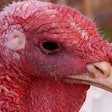
Rotating insecticide classes is critical for successful, long-term darkling beetle control.
Darkling beetles are a common pest in the poultry industry, carrying disease into houses and damaging farm infrastructure. Dr. Doug Ross, technical services manager for Control Solutions Inc., spoke about beetle treatment strategy in turkey houses as part of a technical webinar presented by Aviagen Turkeys on February 24, 2022.

Insecticide resistance
Improper insecticide usage promotes resistance development, leading to beetle control failures.
Ross said in nature genes for insecticide resistance are rare in insects. However, repeatedly spraying the same insecticide class rapidly increases the frequency of resistance genes. In an example he gave, after only five applications of the same insecticide class, control declined to only 30% bugs killed from 89%. This resulted in a control failure and a highly resistant population.
Rotation
Insecticide rotation involves switching, or “rotating,” the insecticide class applied every six months.
There are various insecticide classes registered for beetle control. These include neonicotinoids, organophosphates, pyrethroids, spinosyns and chitin synthesis inhibitors, better known as insect growth regulators.
Ross said rotation involves switching insecticide classes. Using a different chemical in the same insecticide class, for example switching from one pyrethroid to another, is not rotating. An example of rotation is six months of pyrethroid use, six months of organophosphate use, six months of neonicotinoid use and starting the cycle over.
Insect growth regulators can be tank mixed and sprayed with conventional insecticides to improve control. They are most commonly used in the warmer months of the year when beetle populations are higher and more difficult to control or when a severe infestation is encountered.
Why rotate every six months?
There is no single, correct frequency for insecticide rotation to control beetles, but Ross prefers six months for three reasons:
- When using three insecticide classes and rotating every six months, a full year goes by before beetles are exposed to the same chemical class again.
- Darkling beetles are more abundant during the warmer months, so rotation when moving from cold months to warm months fits the natural rhythm.
- Rotating every six months simplifies logistics. Insecticide class purchases must only be changed twice a year.
Application tips
Insecticides must be applied using the proper rate and manner for maximum effectiveness. Ross offered the following tips:
- Calculate the treatment area first. Application rates of most insecticides are expressed in volume per unit area (ounces per 1,000 square feet or milliliters per 100 square meters). Measure the treatment area to apply the correct amount.
- Apply the insecticide at the label rate. Rates are based on extensive research and testing. Using less than the label rate will not work well and can hasten resistance development. Using more than the label rate is illegal and can create residue issues. If there’s a range of rates on a label, always use the highest rate. Poultry litter is a difficult environment for insecticides and the highest rate will give better control.
- Use one to two gallons of water per 1,000 square feet (four to eight liters per 100 square meters) of application area. This spray volume gives adequate coverage.
- Calibrate spray equipment to ensure the speed at which the equipment is moving will provide the correct volume of insecticide to the treatment area. Uncalibrated equipment can spray large amounts too quickly, resulting in one area getting too much treatment and another getting none.
- Apply insecticides as close as possible to bird placement. This is usually three to seven days before placement. Insecticide sprays need to be dry before workers go into the house and prepare to receive birds. Applications should be made after litter or bedding preparation is complete.
- Spray insecticide on top of litter or new bedding, not on the bare floor, before laying bedding down. While this is contrary to common turkey industry practices, applying insecticide to the surface of the litter or bedding will give better results.
- Windrowing can drive beetles out of the litter. This is a good opportunity to spray and kill the exposed beetles.
Application methods
Ross reviewed two different application methods:
- Whole house application involves treating the entire floor area of the house and a portion of the sidewalls. Sometimes, many beetles swarm on the sidewalls between flocks and this presents an ideal opportunity to spray and kill the bugs.
- Band application targets areas where beetles tend to concentrate. Ross said most beetles are found either along the walls or under the feed lines, so application technique only applies insecticide to these areas. Band application uses less insecticide while not treating the entire house. A whole house application can be used with severe infestations.
How to control darkling beetles in broiler houses www.WATTAgNet.com/articles/43069


















